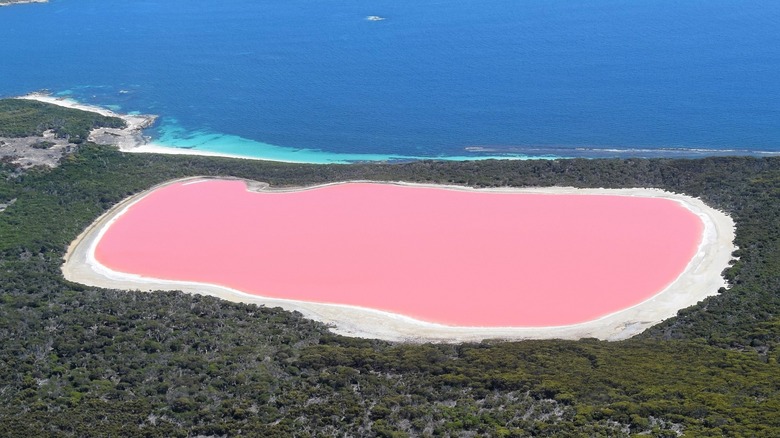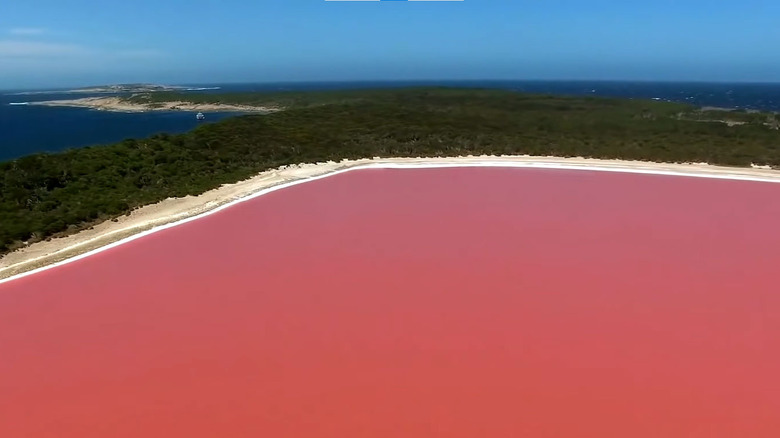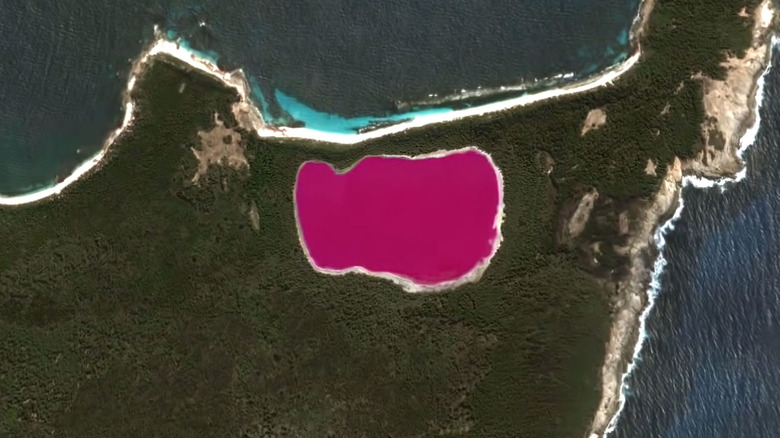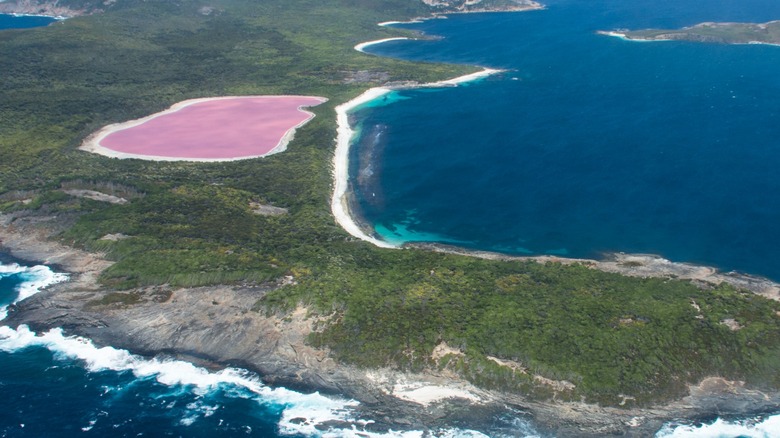What Makes This Australian Lake Pink? Here's The Scientific Cause
Of all the amazing natural phenomena on Earth, one of the more interesting wonders is the neon-pink Lake Hillier in Western Australia. Located on the Recherche Archipelago on Middle Island, the 650-yard-long, 273-yard-wide lake stands as one of the most unique places in the world.
While the pink lake appears to be filled with Pepto Bismol or Pink Sauce, the scientific cause behind the lake's unique color is actually fairly complex, standing as one of the rarest and most unusual examples of nature resulting in something eye-catching.
Discovered in 1802 by British explorer Mathew Flinders, Lake Hillier is one of five pink lakes in Victoria, Australia, alongside Lake Crosbie, Becking, Hardy, and Kenyon sharing a similar phenomenon. Though the lake has been discovered for hundreds of years, it may surprise you to learn that the science behind the pink water of Lake Hillier in Western Australia was not discovered until fairly recently.
The mystery of the pink water was discovered recently
For a long time, the mystery behind the pink-colored water of Lake Hillier was unknown, though many speculated that the high salt content of the lake likely had something to do with it. This speculation came to an end in 2022 when Scott Tighe of the University of Vermont in Burlington teamed up with Ken McGrath of Microbia, an Australian microbial genomics company, to take samples of the water in Lake Hillier.
Once the samples were collected, the team ran DNA sequencing to identify individual microbes found in the pink water, which enabled the identification of the over 500 extremophiles living and propagating in the lake. Interestingly enough, before scientists knew the lake's composition, it was used for salt extraction for years. Today, the lake is left alone. In addition, the lake's water apparently causes no harm to human skin.
The reason behind Australia's pink Lake Hillier
Lake Hillier's neon pink water is ultimately caused by complex biological processes of unique micro-organisms in the saline lake. Lake Hillier possesses at least 500 different species of extremophiles, or bacteria, algae, and viruses that thrive in extreme environments.
Specifically, Lake Hillier contains halophiles, a sub-section of extremophiles that can live in waters with very high levels of salt. Halophiles like the red and orange Salinibacter ruber and red-colored Dunaliella salina are the direct reasons for Lake Hillier's pink hue.
An article published at the American Council on Science and Health explains Lake Hillier's pink color by determining that the halophiles living in the lake evolved to protect themselves from sunlight by developing red, yellow, and orange pigments or carotenoids, to absorb UV light.
Over time, this kept the micro-organisms from being destroyed and is an important tie to the lake's pink color, as this process shielded the organisms from the sun. The water's high salinity enables UV light to penetrate deeper, forcing typically green microalgae like Dunaliella salina to develop the pink hue to protect itself. Essentially, the lake's high salinity and UV light triggered a unique evolutionary process that granted the micro-organisms in Lake Hillier their unique coloration.
Lake Hillier is closed off to tourists
Located 6.8 miles from the coast of Cape Arid National Park, the area around Lake Hillier is a place of unique biodiversity surrounded by dense vegetation and wildlife, including paperbark, eucalyptus trees, honey possums, and wallabies.
Today, Lake Hillier is closed off to the public and inaccessible to tourists, which may help preserve its distinct biodiversity. Much like the Spotted Lake in British Columbia's Okanagan Valley, the Australian Lake Hillier creates a visual not often seen in nature, and human activity and pollution could threaten that.
While created by an entirely different organism called the macarenia clavigera, a similar pink water effect can be found on the other side of the world in Colombia's river of five colors, or Caño Cristales. Though an entirely different scientific phenomenon causes that river's colors, it shows that preservation of our environment is vital if we want future generations to see some of the rare scenes created by Mother Nature.



